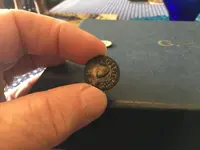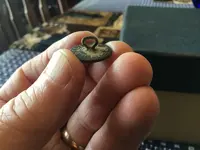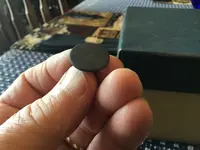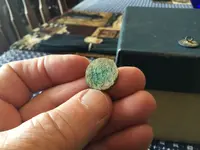You are using an out of date browser. It may not display this or other websites correctly.
You should upgrade or use an alternative browser.
You should upgrade or use an alternative browser.
Old button
- Thread starter Hward56
- Start date
TheCannonballGuy
Gold Member
- Joined
- Feb 24, 2006
- Messages
- 6,606
- Reaction score
- 13,450
- Golden Thread
- 0
- Location
- Occupied CSA (Richmond VA)
- Detector(s) used
- White's 6000, Nautilus DMC-1, Minelab
- Primary Interest:
- Relic Hunting
Hward56 wrote:
> Hunting a old Louisiana plantation daring back to the late 1700... Found this button...cleaned it up best I could...started rubbing into the brass and stopped... Any info would very much be appreciative.
The fact that you did not immediately know exactly what kind of button you dug tells us you need even the most-basic info about it.
It is what button collectors call a flat brass 1-piece button, which relic-diggers call simply a brass flatbutton. The term one-piece means it did not have a separately-made front and back. The loop for sewing it onto the garment does not count as a "piece."
Also, instead of being solid-cast by pouring molten metal into a mold, your flatbutton was made of brass which had been pressed into a sheet, and then discs were stamp-cut out of the sheet. Afterward, sometimes a "backmark" (maker/dealer's name, or a quality-rating) was stamped into what would become the button's back. Then a brass or copper wire loop was brazed or soldered onto the back. The specific type of brass button you found seems to first appear in the mid-to-latter 1700s. Brass ones which have a raised-lettering backmark first appear in the very late 1700s. The first ones having an indented-lettering backmark appeared around 1810. These brass 1-piece flatbuttons fell out of favor with the public in the 1830s due to the advent of inexpensively priced "ornate emblem" 2-piece brass buttons.
Explanation of your brass 1-piece flatbutton's backmark:
One these buttons, the word Gilt always means gold. (Plated meant silverplate.) Treble Gilt means triple-coated with gold.
Rich Orange described the color of the gold. Orange meant the gold contained about 10-to-15% copper, which had the effect of changing the gold's color to orange-ish. When a higher percentage of copper was added into the alloy, like 25% or more, it changed the gold's color to pink-ish… which was/is called Rose Gold.
In summary:
Because your indented-backmark brass 1-piece flatbutton was dug in the US, it dates from about 1810 into the 1830s. The backmark saying Rich Orange indicates it most likely was made in Britain. The War-Of-1812 (to 1815) interrupted the supply from England, and in the years following the war Americans (understandably) disfavored British-made products... therefore, very few of these buttons were imported until the mid-1820s. But by that time, the young American button-making industry had finally become capable of producing large quantities of these 1-piece buttons, thereby diminishing the need to import them.
> Hunting a old Louisiana plantation daring back to the late 1700... Found this button...cleaned it up best I could...started rubbing into the brass and stopped... Any info would very much be appreciative.
The fact that you did not immediately know exactly what kind of button you dug tells us you need even the most-basic info about it.
It is what button collectors call a flat brass 1-piece button, which relic-diggers call simply a brass flatbutton. The term one-piece means it did not have a separately-made front and back. The loop for sewing it onto the garment does not count as a "piece."
Also, instead of being solid-cast by pouring molten metal into a mold, your flatbutton was made of brass which had been pressed into a sheet, and then discs were stamp-cut out of the sheet. Afterward, sometimes a "backmark" (maker/dealer's name, or a quality-rating) was stamped into what would become the button's back. Then a brass or copper wire loop was brazed or soldered onto the back. The specific type of brass button you found seems to first appear in the mid-to-latter 1700s. Brass ones which have a raised-lettering backmark first appear in the very late 1700s. The first ones having an indented-lettering backmark appeared around 1810. These brass 1-piece flatbuttons fell out of favor with the public in the 1830s due to the advent of inexpensively priced "ornate emblem" 2-piece brass buttons.
Explanation of your brass 1-piece flatbutton's backmark:
One these buttons, the word Gilt always means gold. (Plated meant silverplate.) Treble Gilt means triple-coated with gold.
Rich Orange described the color of the gold. Orange meant the gold contained about 10-to-15% copper, which had the effect of changing the gold's color to orange-ish. When a higher percentage of copper was added into the alloy, like 25% or more, it changed the gold's color to pink-ish… which was/is called Rose Gold.
In summary:
Because your indented-backmark brass 1-piece flatbutton was dug in the US, it dates from about 1810 into the 1830s. The backmark saying Rich Orange indicates it most likely was made in Britain. The War-Of-1812 (to 1815) interrupted the supply from England, and in the years following the war Americans (understandably) disfavored British-made products... therefore, very few of these buttons were imported until the mid-1820s. But by that time, the young American button-making industry had finally become capable of producing large quantities of these 1-piece buttons, thereby diminishing the need to import them.
Last edited:
Upvote
0
Relicboy2257
Jr. Member
- Joined
- Mar 25, 2018
- Messages
- 73
- Reaction score
- 223
- Golden Thread
- 0
- Location
- New Jersey
- Detector(s) used
- Garrett AT Pro, Whites Dfx,
- Primary Interest:
- All Treasure Hunting
I agree it definitely a British made button from the early 1820’s - the early 1850’s
Upvote
0
Kray Gelder
Gold Member
- Joined
- Feb 24, 2017
- Messages
- 7,005
- Reaction score
- 12,558
- Golden Thread
- 0
- Location
- Georgetown, SC
- Detector(s) used
- Fisher F75
- Primary Interest:
- Metal Detecting
Cannonballguy, I appreciate your Relic 101 courses ( as well as your advanced ). Good info, always learn something. Thanks for volunteering your knowledge.
Upvote
0
Hward56
Jr. Member
- #6
Thread Owner
What a wealth of knowledge.��..thank you so much...I made a copy of your remarks and I plan to present this button and your remarks to the owners of the plantation...so they can keep it in their plantation home...
May I send you another couple pics of buttons I’ve found from that same plantation?
May I send you another couple pics of buttons I’ve found from that same plantation?
Upvote
0
TheCannonballGuy
Gold Member
- Joined
- Feb 24, 2006
- Messages
- 6,606
- Reaction score
- 13,450
- Golden Thread
- 0
- Location
- Occupied CSA (Richmond VA)
- Detector(s) used
- White's 6000, Nautilus DMC-1, Minelab
- Primary Interest:
- Relic Hunting
Hward56 wrote:
> What a wealth of knowledge.��..thank you so much...
You're welcome.
>I made a copy of your remarks and I plan to present this button and your remarks to the owners of the plantation...so they can keep it in their plantation home...
That's a VERY cool thing to do. Also, it's Good Karma... which I believe "comes back around" to you. (I've seen it happen, many times.).
> May I send you another couple pics of buttons I’ve found from that same plantation?
I think it isn't possible to send pics in a T-Net Private Message... so, just keep doing what you already did... post the pics here in the What Is It? forum. I do not believe that I already know everything there is to know. If you come up with something I cannot ID, there's a decent chance one of the other expert ID-helpers here will know what it is.
> This button was so eaten up....and I could not find any writing on it.
A brass 1-piece flatbutton which has no backmark at all CAN date far back into the 1700s -- but some no-backmark ones continued to be manufactured into the 1830s. That being said... if you dug this one in the same vicinity where you dug your 1810-30s brass flatbutton, it is "most likely" from that same time period.
> What a wealth of knowledge.��..thank you so much...
You're welcome.

>I made a copy of your remarks and I plan to present this button and your remarks to the owners of the plantation...so they can keep it in their plantation home...
That's a VERY cool thing to do. Also, it's Good Karma... which I believe "comes back around" to you. (I've seen it happen, many times.).
> May I send you another couple pics of buttons I’ve found from that same plantation?
I think it isn't possible to send pics in a T-Net Private Message... so, just keep doing what you already did... post the pics here in the What Is It? forum. I do not believe that I already know everything there is to know. If you come up with something I cannot ID, there's a decent chance one of the other expert ID-helpers here will know what it is.
> This button was so eaten up....and I could not find any writing on it.
A brass 1-piece flatbutton which has no backmark at all CAN date far back into the 1700s -- but some no-backmark ones continued to be manufactured into the 1830s. That being said... if you dug this one in the same vicinity where you dug your 1810-30s brass flatbutton, it is "most likely" from that same time period.
Last edited:
Upvote
0
TheCannonballGuy
Gold Member
- Joined
- Feb 24, 2006
- Messages
- 6,606
- Reaction score
- 13,450
- Golden Thread
- 0
- Location
- Occupied CSA (Richmond VA)
- Detector(s) used
- White's 6000, Nautilus DMC-1, Minelab
- Primary Interest:
- Relic Hunting
Kray Gelder wrote:
> Cannonballguy, I appreciate your Relic 101 courses ( as well as your advanced ). Good info, always learn something. Thanks for volunteering your knowledge.
You're welcome.
A personal note: I do what I do here because of the invaluable help I was given, for free, by a couple of "oldtimer" diggers waaay back when I was an un-educated newcomer to metal detecting for Historical relics. I'm paying that help forward to y'all. Also... "What you desire to receive, you must be willing to give."
> Cannonballguy, I appreciate your Relic 101 courses ( as well as your advanced ). Good info, always learn something. Thanks for volunteering your knowledge.
You're welcome.

A personal note: I do what I do here because of the invaluable help I was given, for free, by a couple of "oldtimer" diggers waaay back when I was an un-educated newcomer to metal detecting for Historical relics. I'm paying that help forward to y'all. Also... "What you desire to receive, you must be willing to give."
Last edited:
Upvote
0
Similar threads
- Replies
- 3
- Views
- 183
- Replies
- 4
- Views
- 259
- Replies
- 12
- Views
- 444
Users who are viewing this thread
Total: 1 (members: 0, guests: 1)







